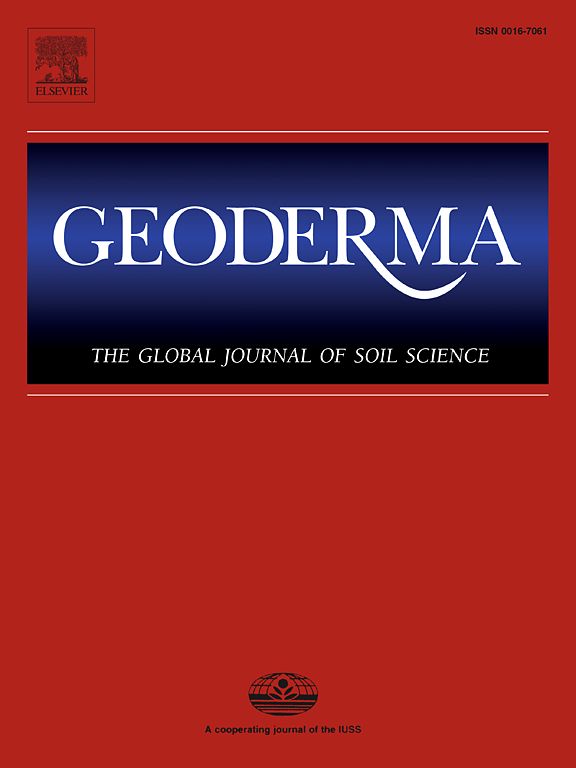Effects of exopolysaccharides from Rhizobium tropici on transformation and aggregate sizes of iron oxides
IF 6.6
1区 农林科学
Q1 SOIL SCIENCE
引用次数: 0
Abstract
Iron oxide transformations in soil significantly impact nutrient availability and plant health. This study investigated the interaction between exopolysaccharides (EPS), produced by Rhizobium tropici, and iron oxide (Fe3O4), focusing on their impact on the transformation, particle size, and zeta potential of iron oxides. The characterization of the EPS-iron oxide composites was carried out using X-ray Powder Diffraction (XRD), Fourier Transform Infrared Spectroscopy (FTIR) and Scanning Electron Microscopy (SEM)/Energy Dispersive X-ray Analysis (EDX). The EPS adsorption kinetics revealed chemisorption and diffusion as controlling processes for EPS adsorption on Fe3O4, while isotherm data with releasing proton indicated possible ion exchange and heterogeneous layered adsorption. Desorption studies suggested the high stability of EPS-iron complexes. Notably, EPS significantly increased the aggregate size of EPS-iron complexes at low EPS/iron oxide molar ratios but shrank the aggregate size at higher ratios (> EPS/iron oxide 2 × 10−4). Additionally, EPS complexation resulted in a shift in the zeta potential towards more negative surface functionality. Functional groups within EPS, specifically –COOH, –OH and –NH played a crucial role in the interaction of EPS with iron oxides. The study concluded that EPS coating prevented the transformation of Fe3O4 into other iron oxide forms like β-FeOOH, α-Fe2O3, and γ-Fe2O3, elucidating the significant role of EPS in soil mineral processes.
热带根瘤菌胞外多糖对氧化铁转化及团聚体大小的影响
土壤中氧化铁的转化对养分有效性和植物健康有显著影响。研究了热带根瘤菌(Rhizobium tropici)产生的胞外多糖(EPS)与氧化铁(Fe3O4)的相互作用,重点研究了它们对氧化铁的转化、粒度和zeta电位的影响。采用x射线粉末衍射(XRD)、傅里叶红外光谱(FTIR)和扫描电镜(SEM)/能量色散x射线分析(EDX)对eps -氧化铁复合材料进行表征。EPS在Fe3O4上的吸附动力学表明,化学吸附和扩散是EPS吸附的控制过程,而释放质子的等温线数据表明可能存在离子交换和非均相层状吸附。解吸研究表明,eps -铁配合物具有较高的稳定性。值得注意的是,EPS在EPS/氧化铁摩尔比较低时显著增加了EPS-铁配合物的团聚体尺寸,而在较高摩尔比时则使团聚体尺寸缩小(>;EPS/氧化铁2 × 10−4)。此外,EPS络合导致zeta电位向更负的表面功能转移。EPS中的官能团,特别是-COOH、-OH和-NH在EPS与氧化铁的相互作用中起着至关重要的作用。研究结果表明,EPS涂层阻止了Fe3O4向β-FeOOH、α-Fe2O3和γ-Fe2O3等其他氧化铁形式的转变,说明EPS在土壤矿物过程中的重要作用。
本文章由计算机程序翻译,如有差异,请以英文原文为准。
求助全文
约1分钟内获得全文
求助全文
来源期刊

Geoderma
农林科学-土壤科学
CiteScore
11.80
自引率
6.60%
发文量
597
审稿时长
58 days
期刊介绍:
Geoderma - the global journal of soil science - welcomes authors, readers and soil research from all parts of the world, encourages worldwide soil studies, and embraces all aspects of soil science and its associated pedagogy. The journal particularly welcomes interdisciplinary work focusing on dynamic soil processes and functions across space and time.
 求助内容:
求助内容: 应助结果提醒方式:
应助结果提醒方式:


